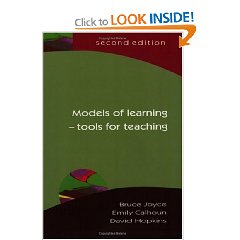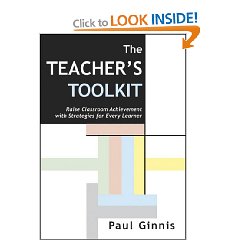 One of the great things of studying in the Education Library at Durham University (instead of at home, in my study) is the books I randomly stumble across. For example, I pulled Models of Learning – Tools for Teaching off the shelf today and it fell open at Chapter 7, entitled ‘Learning through cooperative disciplined inquiry.’
One of the great things of studying in the Education Library at Durham University (instead of at home, in my study) is the books I randomly stumble across. For example, I pulled Models of Learning – Tools for Teaching off the shelf today and it fell open at Chapter 7, entitled ‘Learning through cooperative disciplined inquiry.’
This is perfect for me. One of my Performance Management targets for this year – the one focused on my own classroom practices – is about piloting enquiry-based learning with one of my Year 7 History classes. In addition, I’ll (hopefully) be presenting with Nick Dennis at the SHP Conference in July 2010 on this very topic – including the way technology can help! :-p
It’s always good to have some scholarly research to back up one’s actions, so if you’re planning to do something similar here’s some quotations to help you!
The most stunning thing about teaching people to help kids learn cooperatively is that people don’t know how to do it as a consequence of their own schools and life in this society. And, if anything is genetically driven, it’s a social instinct. If it weren’t for each other, we wouldn’t even know who we are. (Herbert Thelen to Bruce Joyce, circa 1964) p.95
The chapter is based on case studies across the age range, but also contains this nugget on p.98-9:
The assumptions that underlie the development of cooperative learning communities are straightforward:
- The synergy generated in cooperative settings generates more motivation than do individualistic, competitive environments. Integrative social groups are, in effect, more than the sume of their parts. The feelings of connectedness produce positive energy.
- The members of cooperative groups learn from one another. Each learner has more helping hands than in a structure that generates isolation.
- Interacting with one another produces cognitive as well as social complexity, creating more intellectual activity that increases learning when contrasted with solitary study.
- Cooperation increases positive feelings towards one another, reduces alienation and loneliness, builds relationships, and provides affirmative views of other people.
- Cooperation increases self-esteem not only through increased learning but through the feeling of being respected and cared for by others in the environment.
- Students can respond to experience in tasks requiring cooperation by increasing their capacity to work together productively. In other words, the more children are given the opportunity to work together, the better they get at it, with benefit to their general social skills.
- Students, including primary school children, can learn from training to increase their ability to work together.
The authors go on to summarise the evidence about improved learning through collaboration on p.99:
Classrooms where students work in pairs and larger groups… are characterized by greater mastery of material than the common individual-study/recitation pattern. Also, the shared responsibility and interaction produce more positive feelings toward tasks… In other words, the results generally affirm the assumptions that underlie the use of cooperative learning methods.
It’s not hard to get started with cooperative learning (p.100):
[A]n endearing feature is that it is so very easy to organize students into pairs and triads. And it gets effects immediately. The combination of social support and the increase in cognitive complexity caused by the social interaction have mild but rapid effects on the learning of content and skills.
The authors dismiss claims from some teachers that ‘gifted students prefer to work alone’ as the evidence does not back this up (Joyce 1991; Slavin 1991). They believe it may rest on a misunderstanding of the relationship between individual and cooperative study; partnership still requires individual effort. There’s no need to be concerned about students’ ability to work together (p.101):
In fact, partnership s over simple tasks are not very demanding of social skills. Most students are quite capable of cooperating when they are clear about what has been asked of them.
 I’ll not go into them here, but the authors mention a number of ways in which teachers can foster ‘positive interdependence’. They also suggest the ‘division of labour’ into specializations. Instead of learning only a part of what every is supposed to be learning, they have found, ‘jigsaw’ activities and the like lead to more learning across the spectrum. Many of the activities they suggest are, in fact, featured alongside others in one of my favourite education-related books, The Teacher’s Toolkit.
I’ll not go into them here, but the authors mention a number of ways in which teachers can foster ‘positive interdependence’. They also suggest the ‘division of labour’ into specializations. Instead of learning only a part of what every is supposed to be learning, they have found, ‘jigsaw’ activities and the like lead to more learning across the spectrum. Many of the activities they suggest are, in fact, featured alongside others in one of my favourite education-related books, The Teacher’s Toolkit.
The teacher’s role in cooperative learning moves from that of instructor to ‘counsellor, consultant and friendly critic.’ (p.107) The authors note that this ‘is a very difficult and sensitive’ role ‘because the essence of inquiry is student activity’. Teachers need to:
- facilitate the group process
- intervene in the group to channel its energy into potentially educative activities, and
- supervise these educative activities so that personal meaning comes from the experience
The upshot of this is that ‘intervention by the teacher should be minimal unless the group bogs down seriously’ (p.107).
The authors suggest a 6-phase process for cooperative learning:
Phase 1 – Students encounter puzzling situation (planned or unplanned).
Phase 2 – Students explore reactions to the situation.
Phase 3 – Students formulate study task and organize for study (problem definition, role, assignments, etc.)
Phase 4 – Independent and group study.
Phase 5 – Students analyse progress and process.
Phase 6 – Recycle activity.
In conclusion, the authors note how universally cooperative group investigation can be used (p.111-2):
Group investigation is a highly versatile and comprehensive model of learning and teaching: it blends the goals of academic inquiry, social integration and social process learning. It can be used in all subject areas, and with all age levels, when the teacher desires to emphasize the formulation and problem-solving aspects of knowledge rather than the intake of preorganized, predetermined information.




